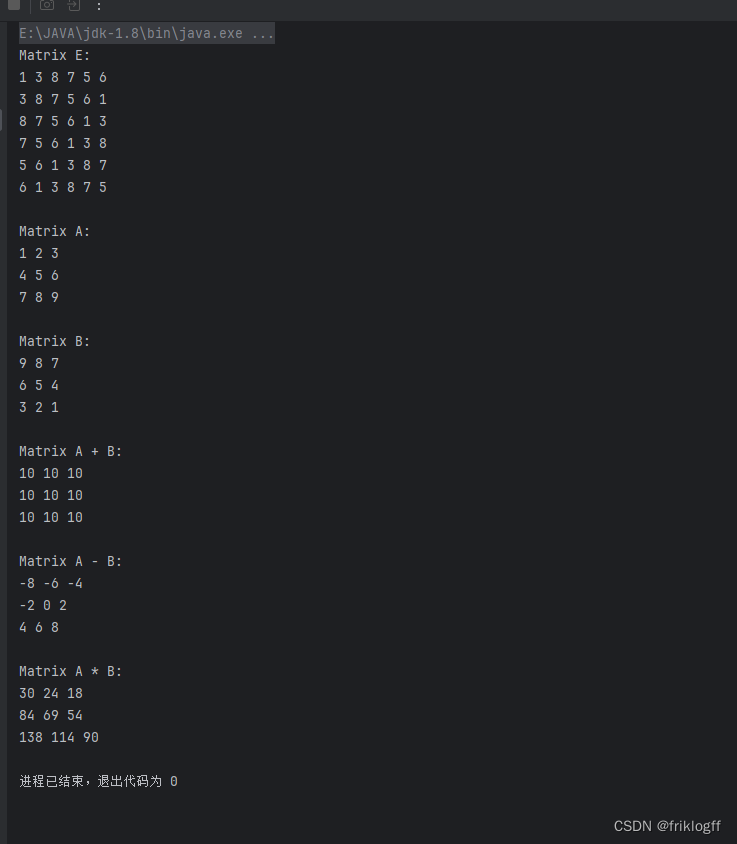实验名称 实验二 类与对象
实验目的
1. 深刻理解类的封装与继承;
2. 熟练掌握类的定义、包与路径、对象的创建、方法的调用、类的继承、方法的重写、运行时多态、访问权限修饰符的使用等;
3. 熟练运用JDK提供的常用类及API。
实验内容(4学时)
1. 定义一个圆形类Circle,包括:
(1)属性:圆心、半径
(2)方法:求面积、周长;上下左右平移;缩放;绘图(虚拟表示)。
设计测试类CircleDemo,在测试类中测试上述方法。以后实验中均自行设计测试类。
class Circle {
private double centerX;
private double centerY;
private double radius;
public Circle(double centerX, double centerY, double radius) {
this.centerX = centerX;
this.centerY = centerY;
this.radius = radius;
}
public double getArea() {
return Math.PI * radius * radius;
}
public double getPerimeter() {
return 2 * Math.PI * radius;
}
public void translate(double deltaX, double deltaY) {
centerX += deltaX;
centerY += deltaY;
}
public void scale(double factor) {
radius *= factor;
}
public void draw() {
System.out.println("Drawing a circle at (" + centerX + ", " + centerY + ") with radius " + radius);
}
}
public class CircleDemo {
public static void main(String[] args) {
Circle circle = new Circle(0, 0, 5.0);
System.out.println("Area: " + circle.getArea());
System.out.println("Perimeter: " + circle.getPerimeter());
circle.translate(2.0, 3.0);
circle.scale(1.5);
circle.draw();
}
}
2. 设计Bird类,包括:(1)属性:name;(2)方法:fly( ),fly方法以及后面提到的各种方法均以字符串输出来演示功能。
以Bird类为超类(父类),设计子类CarrierPigeon,
(1)为CarrierPigeon类新增方法:send(String address, String message)
(2)在CarrierPigeon 覆盖 Bird 的 fly() 方法
public class Bird {
private String name;
public Bird(String name) {
this.name = name;
}
public String getName() {
return name;
}
public void fly() {
System.out.println(name + " is flying.");
}
}
public class CarrierPigeon extends Bird {
public CarrierPigeon(String name) {
super(name);
}
public void send(String address, String message) {
System.out.println(getName() + " is sending a message to " + address + ": " + message);
}
@Override
public void fly() {
System.out.println(getName() + " is flying with a message.");
}
}
public class BirdDemo {
public static void main(String[] args) {
Bird bird = new Bird("Sparrow");
bird.fly();
CarrierPigeon pigeon = new CarrierPigeon("Pigeon");
pigeon.fly();
pigeon.send("Recipient", "Important message");
}
}
3. Java编程实现:设计复数类Complex,类中实部和虚部都是实数,实现加法、减法、乘法和除法。
public class Complex {
private double real;
private double imaginary;
public Complex(double real, double imaginary) {
this.real = real;
this.imaginary = imaginary;
}
public Complex add(Complex other) {
double newReal = this.real + other.real;
double newImaginary = this.imaginary + other.imaginary;
return new Complex(newReal, newImaginary);
}
public Complex subtract(Complex other) {
double newReal = this.real - other.real;
double newImaginary = this.imaginary - other.imaginary;
return new Complex(newReal, newImaginary);
}
public Complex multiply(Complex other) {
double newReal = this.real * other.real - this.imaginary * other.imaginary;
double newImaginary = this.real * other.imaginary + this.imaginary * other.real;
return new Complex(newReal, newImaginary);
}
public Complex divide(Complex other) {
double denominator = other.real * other.real + other.imaginary * other.imaginary;
double newReal = (this.real * other.real + this.imaginary * other.imaginary) / denominator;
double newImaginary = (this.imaginary * other.real - this.real * other.imaginary) / denominator;
return new Complex(newReal, newImaginary);
}
@Override
public String toString() {
return real + " + " + imaginary + "i";
}
}
public class ComplexDemo {
public static void main(String[] args) {
Complex c1 = new Complex(2.0, 3.0);
Complex c2 = new Complex(1.0, 1.0);
Complex sum = c1.add(c2);
Complex difference = c1.subtract(c2);
Complex product = c1.multiply(c2);
Complex quotient = c1.divide(c2);
System.out.println("Sum: " + sum);
System.out.println("Difference: " + difference);
System.out.println("Product: " + product);
System.out.println("Quotient: " + quotient);
}
}
4. Java编程实现:设计矩阵类Matrix,类中的方法能对矩阵进行加法、减法和乘法运算。在矩阵中再定义一个方法,生成如下的矩阵:

public class Matrix {
private int[][] data;
public Matrix(int[][] data) {
this.data = data;
}
// 获取矩阵的行数
public int getRows() {
return data.length;
}
// 获取矩阵的列数
public int getColumns() {
return data[0].length;
}
// 矩阵加法
public Matrix add(Matrix other) {
if (getRows() != other.getRows() || getColumns() != other.getColumns()) {
throw new IllegalArgumentException("矩阵维度不匹配");
}
int[][] result = new int[getRows()][getColumns()];
for (int i = 0; i < getRows(); i++) {
for (int j = 0; j < getColumns(); j++) {
result[i][j] = data[i][j] + other.data[i][j];
}
}
return new Matrix(result);
}
// 矩阵减法
public Matrix subtract(Matrix other) {
if (getRows() != other.getRows() || getColumns() != other.getColumns()) {
throw new IllegalArgumentException("矩阵维度不匹配");
}
int[][] result = new int[getRows()][getColumns()];
for (int i = 0; i < getRows(); i++) {
for (int j = 0; j < getColumns(); j++) {
result[i][j] = data[i][j] - other.data[i][j];
}
}
return new Matrix(result);
}
// 矩阵乘法
public Matrix multiply(Matrix other) {
if (getColumns() != other.getRows()) {
throw new IllegalArgumentException("矩阵维度不匹配");
}
int[][] result = new int[getRows()][other.getColumns()];
for (int i = 0; i < getRows(); i++) {
for (int j = 0; j < other.getColumns(); j++) {
int sum = 0;
for (int k = 0; k < getColumns(); k++) {
sum += data[i][k] * other.data[k][j];
}
result[i][j] = sum;
}
}
return new Matrix(result);
}
// 生成指定的矩阵
public static Matrix createMatrixE() {
int[][] eMatrixData = {
{1, 3, 8, 7, 5, 6},
{3, 8, 7, 5, 6, 1},
{8, 7, 5, 6, 1, 3},
{7, 5, 6, 1, 3, 8},
{5, 6, 1, 3, 8, 7},
{6, 1, 3, 8, 7, 5}
};
return new Matrix(eMatrixData);
}
// 打印矩阵
public void printMatrix() {
for (int i = 0; i < getRows(); i++) {
for (int j = 0; j < getColumns(); j++) {
System.out.print(data[i][j] + " ");
}
System.out.println();
}
}
public static void main(String[] args) {
Matrix matrixE = createMatrixE();
System.out.println("Matrix E:");
matrixE.printMatrix();
Matrix matrixA = new Matrix(new int[][] {
{1, 2, 3},
{4, 5, 6},
{7, 8, 9}
});
Matrix matrixB = new Matrix(new int[][] {
{9, 8, 7},
{6, 5, 4},
{3, 2, 1}
});
System.out.println("\nMatrix A:");
matrixA.printMatrix();
System.out.println("\nMatrix B:");
matrixB.printMatrix();
Matrix matrixSum = matrixA.add(matrixB);
System.out.println("\nMatrix A + B:");
matrixSum.printMatrix();
Matrix matrixDifference = matrixA.subtract(matrixB);
System.out.println("\nMatrix A - B:");
matrixDifference.printMatrix();
Matrix matrixProduct = matrixA.multiply(matrixB);
System.out.println("\nMatrix A * B:");
matrixProduct.printMatrix();
}
}
实验程序及结果(附录)
思考
以C为代表的结构化编程语言和以Java为代表的面向对象编程语言有哪些本质不同?
关于结构化编程语言(以C为代表)和面向对象编程语言(以Java为代表)的本质不同:
- 抽象与封装:面向对象编程强调对象的抽象和封装,允许将数据和操作封装在对象内部,提供更好的信息隐藏和模块化。结构化编程相对较少使用对象,更多地依赖于函数和数据的分离。
- 继承与多态:面向对象编程支持继承和多态,允许创建层次结构的类,重用代码并实现多态性。结构化编程通常较少使用这些概念,更注重逻辑流程和模块化设计。
- 对象:面向对象编程以对象为中心,将数据和操作封装在对象中。结构化编程更倾向于使用数据结构和函数。
- 设计模式:面向对象编程强调设计模式,例如单例模式、工厂模式等,以提供更好的可维护性和可扩展性。结构化编程通常较少使用这些模式。
- 类型系统:面向对象编程通常有更强的类型系统,支持多态和动态绑定。结构化编程的类型系统通常较为简单。
总之,面向对象编程更注重数据和操作的封装、继承、多态等概念,而结构化编程更注重逻辑流程和分离数据和函数。不同编程范式适用于不同类型的问题和项目。